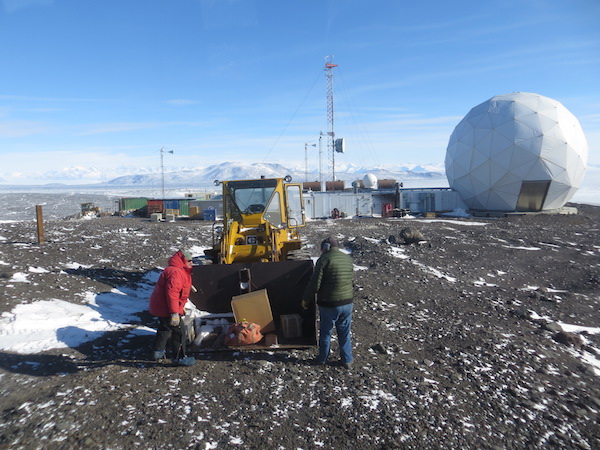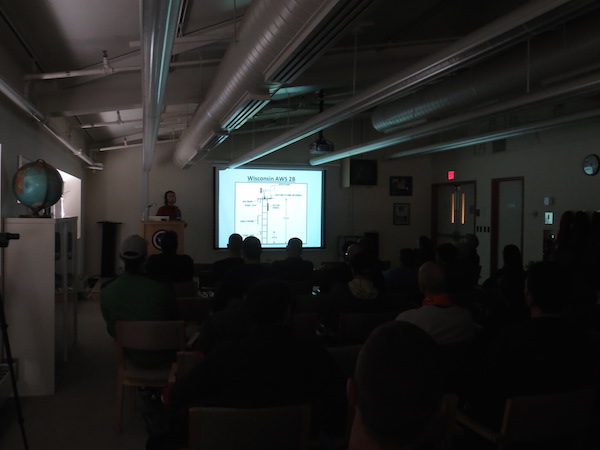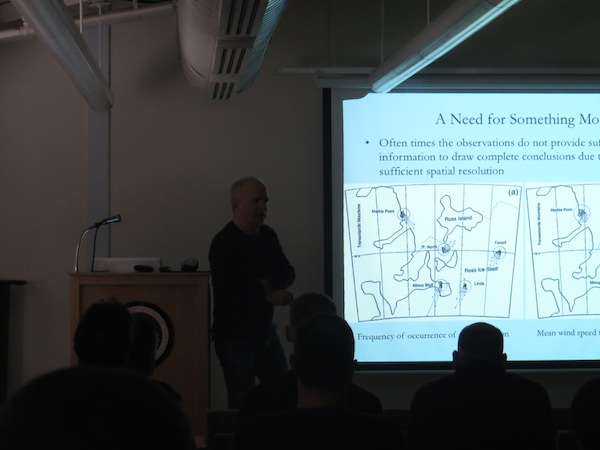Fourth times a charm.
Mark and I visited White Island AWS yesterday, 4 November, to do a station inspection. It was our fourth day of being on the helicopter (helo) schedule to visit the site. (For the record, helo flights are much easier to plan around compared to Twin Otter because helo flights don’t usually take up an entire day.) The first two days, we were canceled due to weather. The third day, 3 November, it was windy in McMurdo but it appeared okay at White Island. We departed McMurdo on the helo, but as we approached White Island we saw a low cloud/fog bank creeping over the tallest part of the island, Mt Heine, where our AWS is situated. The helos are unable to fly through clouds such as that, for obvious safety reasons, so we had to turn back. That cloud bank may have been the beginning of some poor weather in McMurdo, as the rest of the day was quite windy (15-20 mph, air temp around -5F, wind chills down to -30F) in town with a lot of blowing and drifting snow.
Yesterday was the fourth time we tried, and we got there. Our goal was to inspect the station to make sure instruments and cables looked fine. One point of concern for us was the state of the wind monitor. White Island experiences strong winds (even possibly the highest wind speed ever recorded at a UW AWS! More on that later….), and we don’t have a high wind speed sensor installed. We just have our standard RM Young wind monitor.
On our way to White Island, we dropped of one passenger, an electrical technician, at Black Island (the two islands are essentially right next to each other and about a 15 minute flight from McMurdo).
The winds were quite strong at Black Island (~50 mph) as they usually are, but our AWS at White Island was recording winds at only~10 mph.
I have never been to Black Island, and consequently never seen the area between the two islands. It looked pretty cool, especially with the blue ice.
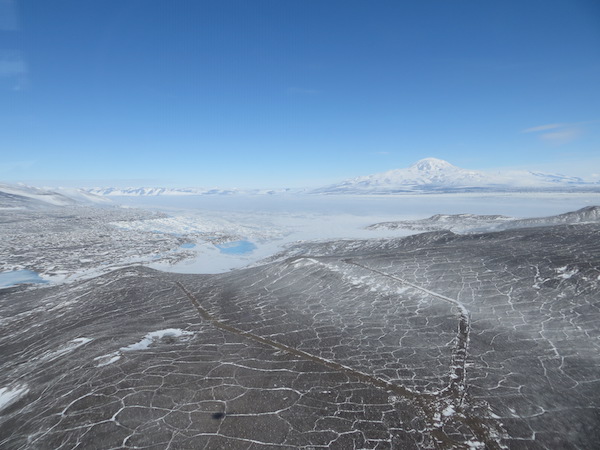
The view on our way from Black Island to White Island. Black island is pictured in the foreground, with Mt Discovery in the background.
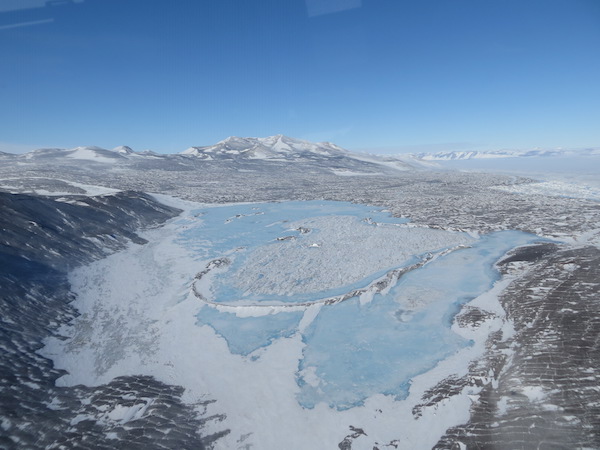
A blue ice field. There is no net snow accumulation, mostly due to the high winds, so the ice is exposed.
We approached White Island and negotiated a good spot to land the helo. Once safely on the ground, Mark and I grabbed our bags and made the short hike up to the station.
The winds were fairly calm when we first arrived at the AWS, which was a little surprising considering how strong they were at Black Island. Mark and I shrugged it off and started inspecting the station. We checked the instruments to make sure nothing was broken, checked the cabling to make sure it was still secured. In particular, we looked for damage to the wind monitor at the top of the station.
Back in July of this year, a high wind speed affected the area surrounding White Island. For about half a day, wind speeds at White Island AWS were around 60 m/s (134 mph!). The wind speed peaked at 62.7 m/s (140.3 mph) which, if verified, would set the record for highest wind speed ever recorded at one of our AWS!
With good reason, we were curious to see the state of the wind monitor. In most cases, we would install a high wind speed system at a site that recorded such wind speeds. Since White Island AWS was only installed 4 years ago, and it’s our first AWS on this island, we weren’t sure how high the wind speeds were. We think we’re getting the idea now.
Speaking of high winds, after about 10 minutes of Mark and I checking the AWS, the winds started to pick up. There was actually a time when the wind went from calm, to a sustained wind of about 20 mph for 30 seconds, then calm again. It was very strange. After a couple minutes of calm winds, it picked up again and remained gusty. For the last 20-30 minutes of our visit, winds were measuring a sustained wind speed of around 30 mph with gusts around 40 mph. Here are the obs, recorded from White Island AWS and posted on our website, during our visit:
STATION JULDATE TIME T(C) P(MB) SPD(M/S) DIR(DEG)
White Island 2015308 000000 -24.5 895.1 3.3 191 White Island 2015308 001000 -25.8 894.5 8.7 180 White Island 2015308 002000 -26.5 894.5 12.3 191 White Island 2015308 004000 -26.7 894.0 12.3 192 White Island 2015308 005000 -26.6 894.1 13.2 193
The time is listed in UTC, and since NZDT is 13 hours ahead of UTC, the first observation listed corresponds to 1 pm on Julian day 308, or 4 November. We landed at 12:55 pm, so it just about matches up with our ground time. We departed at 1:45 pm. Also, one thing to note about the observations is that there is an observation missing at 003000, or 1:30 pm NZDT. This is because we had powered down the AWS to troubleshoot some issues with the data card on board the data logger.
As a fun fact, at 1:40 pm the air temperature was -16.1 F, so with a recorded wind speed of 27.5 mph the wind chill was -46.7 F! That’s almost as cold as I experienced at the South Pole last season!
After Mark and I got back into town, we changed gears a bit and did some final preparations for our presentation at the Crary Wednesday Science Lecture. Crary is the building in which our group and many other science groups work. Every Wednesday, a person or group will give a talk about their work or research they’re doing. Mark and I talked about “Telling Antarctic Meteorology Stories: From Observations to Modeling.” For the first half of the presentation, I spoke about the history of our AWS program and touched on some research that has been done with AWS data. Then Mark talked about how observations can be used to improve weather models and likewise spoke about some research using such models. It turned out very well!


